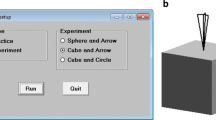Abstract
Background
In image-guided procedures, a high level of visual spatial ability may be an advantage for surgical trainees. We assessed the visual spatial ability of surgical trainees.
Methods
Two hundred and thirty-nine surgical trainees and 61 controls were tested on visual spatial ability using 3 standardised tests, the Card Rotation, Cube Comparison and Map-Planning Tests.
Results
Two hundred and twenty-one, 236 and 236 surgical trainees and 61 controls completed the Card Rotation test, Cube Comparison test and Map-Planning test, respectively. Two percent of surgical trainees performed statistically significantly worse than their peers on card rotation and map-planning test, > 1% on Cube Comparison test. Surgical trainees performed statistically significantly better than controls on all tests.
Conclusions
Two percent of surgical trainees performed statistically significantly worse than their peers on visual spatial ability. The implication of this finding is unclear, further research is required that can look at the learning and educational portfolios of these trainees who perform poorly on visual spatial ability, and ascertain if they are struggling to learn skills for image-guided procedures.





Similar content being viewed by others
References
Cuschieri A (1995) Whither minimal access surgery: tribulations and expectations. Am J Surg 169(1):9–19
Gallagher AG, Smith CD (2003) From the operating room of the present to the operating room of the future. Human-factors lessons learned from the minimally invasive surgery revolution. Semin Laparosc Surg 10(3):127–139
Editorial (1991) Cholecystectomy practice transformed. Lancet 338(8770):789–790
Hanna GB, Cuschieri A (2000) Influence of two-dimensional and three-dimensional imaging on endoscopic bowel suturing. World J Surg 24(4):444–449
Crothers IR et al (1999) Experienced laparoscopic surgeons are automated to the “fulcrum effect”: an ergonomic demonstration. Endoscopy 31(5):365–369
Gallagher AG et al (1998) An ergonomic analysis of the fulcrum effect in the acquisition of endoscopic skills. Endoscopy 30(7):617–620
Satava R (2007) The future of surgical simulation and surgical robotics. Bull Am Coll Surg 92(3):13–19
Smith R, Patel V, Satava R (2014) Fundamentals of robotic surgery: a course of basic robotic surgery skills based upon a 14-society consensus template of outcomes measures and curriculum development. Int J Med Robot Comput Assist Surg 10(3):379–384
Chamberlain RS, Sakpal SV (2009) A comprehensive review of single-incision laparoscopic surgery (SILS) and natural orifice transluminal endoscopic surgery (NOTES) techniques for cholecystectomy. J Gastrointest Surg 13(9):1733–1740
McClusky DA 3rd et al (2005) Correlation between perceptual, visuo-spatial, and psychomotor aptitude to duration of training required to reach performance goals on the MIST-VR surgical simulator. Am Surg 71(1):13–20; discussion 20–1
Henn P et al (2017) A computerised test of perceptual ability for learning endoscopic and laparoscopic surgery and other image guided procedures: score norms for PicSOr. Am J Surg 214:969–973
Ritter EM et al (2006) Perceptual, visuospatial, and psychomotor abilities correlate with duration of training required on a virtual-reality flexible endoscopy simulator. Am J Surg 192(3):379–384
Gallagher AG et al (2001) Objective psychomotor skills assessment of experienced, junior, and novice laparoscopists with virtual reality. World J Surg 25(11):1478–1483
Gallagher AG, Satava RM (2002) Virtual reality as a metric for the assessment of laparoscopic psychomotor skills. Learning curves and reliability measures. Surg Endosc 16(12):1746–1752
Ekstrom RB, French JW, Harman HH, Dermen D (1976) Manual for kit of factor-referenced cognitive tests. Educational Testing Service, Princeton, NJ
Gallagher AG et al (2003) Psychomotor skills assessment in practicing surgeons experienced in performing advanced laparoscopic procedures. J Am Coll Surg 197(3):479–488
Wanzel KR et al (2007) Visual-spatial ability and fMRI cortical activation in surgery residents. Am J Surg 193(4):507–510
Gallagher AG et al (2014) An objective evaluation of a multi-component, competitive, selection process for admitting surgeons into higher surgical training in a national setting. World J Surg 38(2):296–304
Gallagher AG et al (2003) PicSOr: an objective test of perceptual skill that predicts laparoscopic technical skill in three initial studies of laparoscopic performance. Surg Endosc 17(9):1468–1471
Westman B et al (2006) Visuospatial abilities correlate with performance of senior endoscopy specialist in simulated colonoscopy. J Gastrointest Surg 10(4):593–599
Ritter EM et al (2003) Objective psychomotor skills assessment of experienced and novice flexible endoscopists with a virtual reality simulator. J Gastrointest Surg 7(7):871–877 discussion 877–8.
Gallagher AG et al (2005) Virtual reality simulation for the operating room: proficiency-based training as a paradigm shift in surgical skills training. Ann Surg 241(2):364–372
Gallagher AG, O’Sullivan GC (2011) Fundamentals of surgical simulation; principles & practices. Springer, London
Andersen DK (2012) How can educators use simulation applications to teach and assess surgical judgment? Acad Med 87(7):934–941
Stefanidis D et al (2006) Psychomotor testing predicts rate of skill acquisition for proficiency-based laparoscopic skills training. Surgery 140(2):252–262
Funding
No funding including equipment was received from any source in the public, commercial or not-for-profit sectors. No funding was received from any source either pharmaceutical or other agency for the drafting of this manuscript.
Author information
Authors and Affiliations
Corresponding author
Ethics declarations
Disclosures
Patrick Henn, Anthony G Gallagher, Emmeline Nugent, Neal E Seymour, Randy S Haluck, Hazem Hseino, Oscar Traynor and Paul C Neary have no conflicts of interest or financial ties to disclose.
Ethical approval
Ethical approval was granted by the Research Ethics Committee of the Royal College of Surgeons in Ireland. All participants gave informed and written consent to have any data collected as part of the assessment process analysed and used for research purposes.
Rights and permissions
About this article
Cite this article
Henn, P., Gallagher, A.G., Nugent, E. et al. Visual spatial ability for surgical trainees: implications for learning endoscopic, laparoscopic surgery and other image-guided procedures. Surg Endosc 32, 3634–3639 (2018). https://doi.org/10.1007/s00464-018-6094-3
Received:
Accepted:
Published:
Issue Date:
DOI: https://doi.org/10.1007/s00464-018-6094-3




